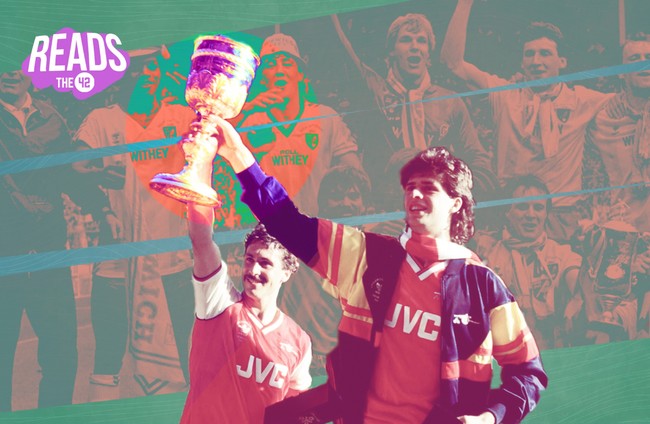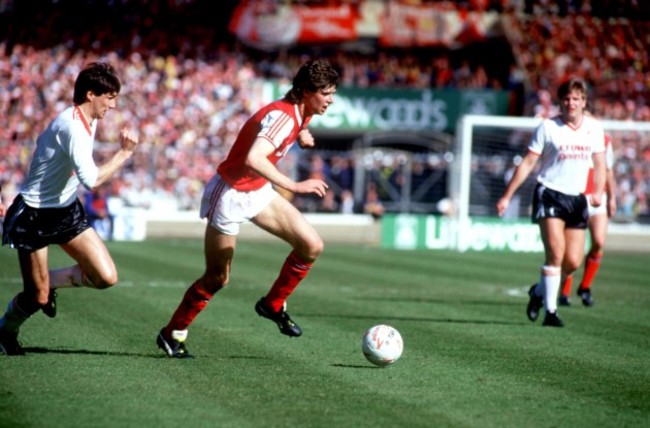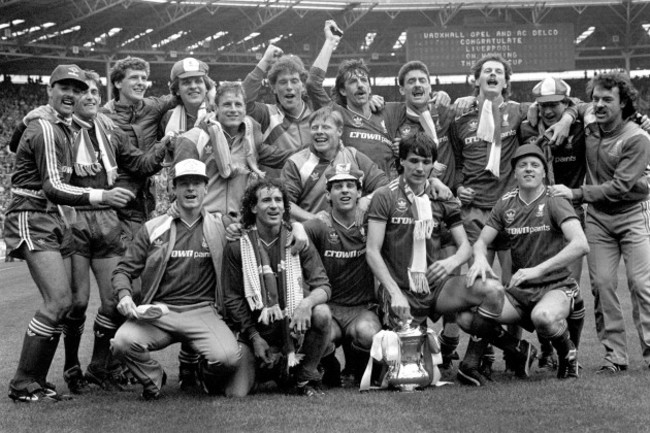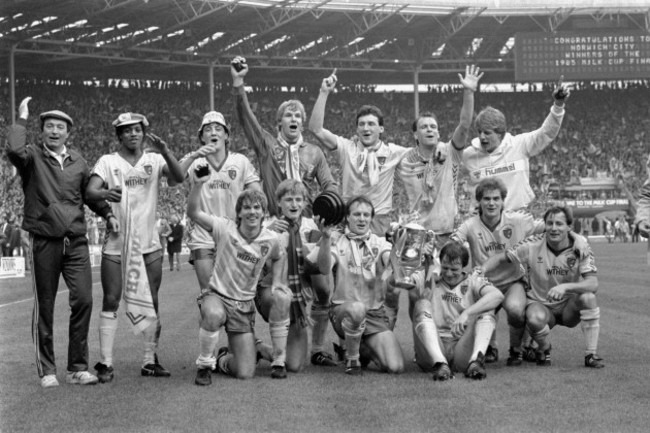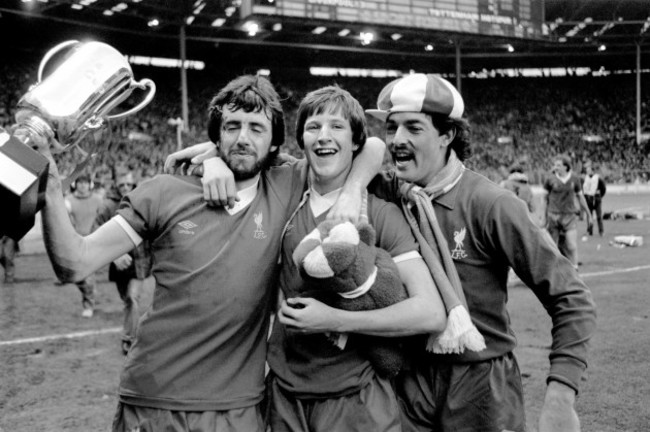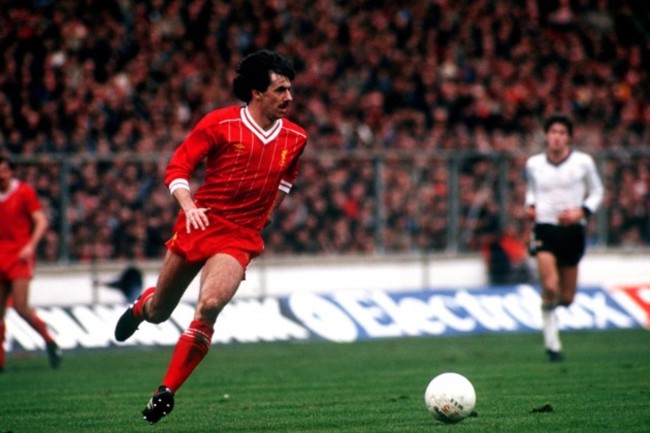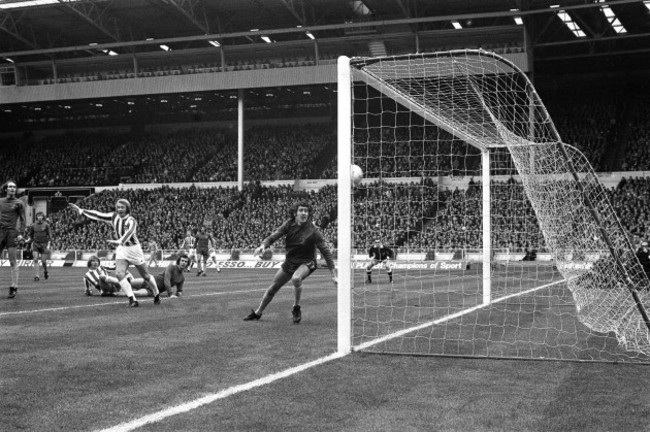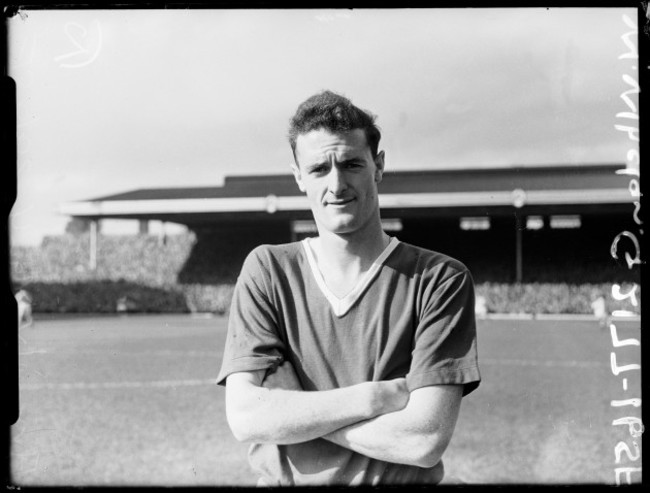THE ARSENAL No9 sighed into the launderette on Enfield High Street with a bit of a head on him.
The night before had been fun. The Green Gate pub near Palmer’s Green had kept their doors open late, acknowledging the presence of the Arsenal double winning captain, Frank McLintock, and their young Irish centre forward, Niall Quinn. Earlier that day, Quinn had helped Arsenal win their first trophy in eight years and just their second since McLintock lifted the 1971 league and cup.
“We stayed until the wee hours,” Quinn recalls, remembering the uncle he was named after explaining to McLintock why Irish trainers didn’t have a particularly good year at Cheltenham. “There’s no money,” Niall senior said.
There wasn’t much more in his nephew’s bank account. He may have been an Ireland international, may have been in his second season as a first-teamer at the third most successful club in English football history, but he was still on £175-a-week and couldn’t afford a washing machine in his compact two-bed apartment.
So Monday after Monday, Arsenal’s No9, a player who would go on to spend half his career with two of the clubs involved in this week’s ill-fated Super League, filled a rucksack with jocks and socks, shorts, jeans and t-shirts, and lugged it down the street to the local washateria, the stink of deep heat, mud, sweat and aftershave wafting off it as he walked.
This day was no different. April 25, 1987. Never mind that the afternoon before he’d played 73 minutes in front of 96,000 people at Wembley, helping Arsenal beat Liverpool 2-1. If he wanted clean clothes to wear, then he had to load the machine at The Wash Shop; the bookies next door helping him fight the boredom.
“They were great times,” Quinn says. “There were no camera phones. You could do something like that, place a bet or two, and not worry about it becoming a thing. Myself and the lads (flatmates Yosser and Kiddo) were just typical young Irish lads over in London.”
Well, they were and they weren’t. Yosser and Kiddo took the tube to work from Monday to Friday whereas Quinn’s employers had other plans for him on a Saturday afternoon. Highbury was the name of his workplace. Like almost every other Irish player in that period, he may have lived an ordinary life but he was expected to do extraordinary things.
And like almost every other Irish player in that period, he delivered.
**
THE GREATEST ERA in the history of Irish football begins on a sunny day in 1980. John Devine walks down the Wembley tunnel closely followed by David O’Leary, Liam Brady and Frank Stapleton: four Dubs, one dream.
An hour and 45 minutes later it’s shattered. There won’t be a mini-tour of Dublin’s northside with the FA Cup; instead it’ll do the rounds in London’s east end. Highbury’s Irish connection is soon diluted, Brady leaving that summer, Stapleton a year later, Devine two years after that.
Little were they to know, though, what they’d started. Throughout the 1980s, you couldn’t switch onto one of English football’s showpiece occasions without seeing an Irish flag-bearer. In the FA Cup alone, you had Tony Galvin and Chris Hughton, winners with Tottenham in ’81 and ’82; Manchester United’s Ashley Grimes, Kevin Moran and Stapleton took hold of the baton in ’83; the latter pair winning again in ’85 alongside Paul McGrath; Liverpool’s Jim Beglin, Ronnie Whelan and Mark Lawrenson were successful in ’86; Wimbledon’s Terry Phelan in ’88; Whelan, Steve Staunton, John Aldridge and Ray Houghton in ’89.
This was also a decade when 11 different Irish internationals – Steve Heighway, Michael Robinson, Whelan, Beglin, Lawrenson, Aldridge, Houghton, Eamonn Deacy, Kevin Sheedy, David O’Leary, Niall Quinn – played on league championship winning sides; when Heighway, Robinson, Whelan, Lawrenson, Hughton, Galvin and Sheedy won European medals and when something else happened: Ireland ‘owned’ the League Cup.
From Liverpool’s win in the 1981 final, right through to Aston Villa’s victory over Leeds United in the 1996 decider, there was at least one Irish player in the match-day squad of England’s League Cup winners.
You may say so what, that it is only the League Cup, a trophy diluted in value by its variety of sponsors: from Milk through to Littlewoods, Rumblelows, Carling, Coca-Cola, Worthingtons, Capital One and now Carabao.
And there was a time when we’d have nodded our heads in approval. The treble winning legacy left by Roy Keane and Denis Irwin in 1999 was much greater. The events of Euro ’88 and Italia ’90 are still generating spin-offs for filmmakers who trade in nostalgia, delivering for an audience beaten down by present-day mediocrity.
And be under no illusion about how grim it is to be an Irish football supporter, today. The national team are just after losing to Luxembourg; the team-sheets at Liverpool, Chelsea, Manchester United, Arsenal and Manchester City don’t have an Irish name on it. Tottenham’s is slightly different, of course. Matt Doherty has an outside chance of starting tomorrow’s Carabao Cup final but more likely, he’ll be a sub, watching on, wondering, hoping, praying his side can win and Ireland’s dearth of major medal winners will come to an end.
Ten years have elapsed since someone from here (Birmingham’s Keith Fahey and Steve Carr) last lifted this trophy – but not all that long ago it was different. Once upon a time, Irish football had shares in it.
**
“Elation; relief; joy; pride.” John Devine is describing Wembley 1985 and how it felt to carry the pressure of a city and county, to be an influencer but a humble one. When Ken Brown pulled Devine aside the day before the final to tell him he’d be a sub, he knew how to react.
“You can go one of two ways,” he says now, 36 years on. “You can sulk and feel sorry for yourself or you can pull yourself together and remember you did your bit getting the team to Wembley; that you are a part of it.”
Only 55 Irishmen have been ‘part’ of a League Cup final squad and only 28 know what is like to win it. John Giles, the grandfather of Irish football, was the first, winning with Leeds in 1968. Terry Conroy was next, scorer of Stoke’s first goal in their 2-1 victory over Chelsea in 1972. “I’m one of 28?” Conroy asks, in disbelief. “Seriously? Wow! It is very personal to hear something like that. Sometimes you should give yourself a pat on the back. To be among the elite; you mustn’t have been too bad.”
Liverpool were the elite throughout the 1980s, winners of six League titles, two European Cups, two FA Cups and, from 1981 through to 1984, four successive League Cups. The 1982 final, a 3-1 win over Tottenham, was the first of three Lawrenson and Whelan would win. “I left Brighton in August ’81 because I wanted to win things, so that Spurs victory was a big deal,” Lawrenson said.
“I remember staring at the medal; honestly you’d have thought it had come out of a lucky bag. Still, I remember staring at the inscription: Milk Cup champions. I felt vindication for making the move, choosing Liverpool rather than United or Arsenal. Expectations were always high at the club. The final was in March; to win then, you thought, ‘right that’s one trophy, let’s kick on’.”
Kicking was what Graeme Souness did well, whether it was the ball or the opposition. “Tony Galvin was destroying us that day,” Lawrenson said. “Graeme went across and cut him in half, as you do. He was some player, Graeme. We had strength in midfield.”
They had it everywhere. The centre-back pairing, Lawrenson and Hansen, was one of those partnerships synonymous with the ‘80s, like Cagney and Lacey; Del Boy and Rodney; Chas & Dave. In midfield Liverpool also had Dublin’s Whelan, scorer of two goals that day, scorer of the winner in the ’83 final.
By 1985, though, their grip on the trophy had slipped, Tottenham knocking them out in the third round. That year the League Cup final was to be decided between two regional teams; Sunderland and John Devine’s Norwich. “I’ll never forget the dressing room beforehand,” Devine recalls, “Mick Channon looking around at three or four of the local lads, sensing their nervousness.
“Hey,” he piped up. “Just remember lads, you may never get chance like this again. Don’t be shy today; don’t leave anything out there.” Channon knew by then how time can slip by, nine years having passed since his previous Wembley Cup final win. Sitting across the Norwich dressing room, Asa Hartford had also waited nine years, after lifting the ’76 League Cup with Manchester City.
John Deehan’s purgatory was shorter, just the eight years separating his League Cup triumph with Aston Villa and the latter success he’d have with Norwich.
For goalkeeper Chris Woods, the League Cup was also where it started for him, with Nottingham Forest in ’78. Then there were the centre backs, Dave Watson and Steve Bruce. They’d go on to greater things, Watson helping Everton to the league in ‘87, Bruce winning almost everything with Manchester United.
“Brucie sat on the back seat of the bus on the way home alongside myself, Chris Woods, Dave Watson and Mick Channon. I had the guitar out,” Devine says. “We were singing away. Sinatra, Neil Diamond, Elvis. Brucie loved a bit of Elvis. Coming into Norfolk, I decided to have a bit of craic. ‘Here lads, listen to this one,’ I said. ‘This is an Irish song…. ‘We’re On The One Road’.”
**
Niall Quinn was nearly on the wrong road. December, 1986. Port Vale wanted him on loan. Thursday morning, he went back to that apartment in Enfield and packed his bags. Thursday evening, he unpacked them. Paul Mariner and Tony Woodcock had picked up injuries in training earlier that day. “Niall,” manager Don Howe said to him. “You’re in.”
He was 20, raw and in awe. “During the warm-up, I looked across, saw Mark Lawrenson and Alan Hansen going through their drills and instantly thought. “Oh no, I’m in trouble here.”
He needn’t have worried. Quinn scored that day; Arsenal won 2-0 in the inaugural English First Division game broadcast live across Europe. “I went from being a nobody to getting fan mail from Norway and Sweden in the space of three days,” Quinn says.
However, the postman wasn’t too busy around Highbury over the remainder of the season. Howe would leave in May, frustrated by the inability of his big-name players to deliver. Enter George Graham; exit some of the big name players. “George placed his trust in youth; and luckily I was part of that,” says Quinn.
They went on a roll, winning 13 and drawing four league games from September to January, going top of the table. Cup runs followed, David Pleat’s outstanding Spurs team waiting for them in the League (then Littlewoods) Cup semi-finals. Tottenham won the first leg, 1-0, Arsenal the second game, 2-1. Onto the replay – again Tottenham led, again Arsenal came back.
“That made winning the Cup a bigger deal,” says Quinn, “the fact it was Spurs we knocked out to make it to Wembley …. as well as the fact they probably should have beaten us.”
There was no time for reflection. Graham booked them into Herbie Froggs, a tailor on Saville Row. Cup final was on a Sunday and Quinn hadn’t been this well turned out since his communion day. It wasn’t the only reminder of home, 17 family members coming across from Dublin and Tipperary for the game. He played well, nearly scoring a winner before Charlie Nicholas eventually did. Liverpool, maestros of the League Cup, had eventually lost a final, 2-1. “From that win, the fans had belief in George Graham that we would go on and do big things.”
Sadly, Graham didn’t share that trust with many of those Cup winners. Nicholas would be sold to Aberdeen; Kenny Sansom, the captain, to Newcastle; Viv Anderson was shipped out to Manchester United; Steve Williams to Luton Town; Martin Hayes to Celtic. Quinn, meanwhile, stayed on for another three years, as back up to Alan Smith. “That day at Wembley, I’ll never forget it,” he says. “My first major medal, but I also remember seeing Smudger (Smith) in the stands. He was just after being signed by George from Leicester. So there were these mixed emotions: we’d won something big but the pressure was already on.”
**
Lawrenson was under pressure from the moment he walked into Anfield, Liverpool having spent £900,000 on him, making him the third biggest transfer in British football history. Bob Paisley greeted him at the airport. “We know you can play anywhere,” he said.
Worried by the club’s reputation of sticking new signings in the reserves for 18 months ‘to learn the Liverpool way’, Lawrenson was pleasantly surprised when he was handed his debut a few days later, as a left back. “The thing with footballers, especially if you go for big money, is that you want that nod of approval from your team mates. You dread the idea of them thinking ‘what a barrel of shit we have signed here’. That was my biggest fear.”
He need not have worried. Paisley left him out the team for Brighton, shortly after signing him, a decision he regretted after a 2-2 draw. “Don’t worry, son,” he said to Lawrenson afterwards. “I’ll never make that mistake again.”
He was on his way. Three League Cups (a record for an Irishman, shared with Whelan), five league titles, a FA Cup and a European Cup followed for a player who deserves to be shortlisted as one of Ireland’s greatest.
“Bob was brilliant to me; it was like having your granddad in charge of the team,” Lawrenson said. “His greatest asset was identifying players who fitted into the system. The bootroom basically ran the team. Bob was strong but quite a quiet man.”
**
Tony Waddington was louder. “He had charm,” says Conroy of the only Stoke City manager to guide the club to a major trophy. He had a salesman’s gift of the gab – so when Gordon Banks became available, Tony didn’t think twice about convincing him to come to us. Think about it, Banksie was England’s No1, a World Cup winner whereas Stoke had never won anything. But Tony, Tony could have persuaded Messi and Ronaldo to sign for us. He just had something.”
You could say the same about Ken Brown who managed Devine at Norwich. “Players had more of a rapport with the manager back then,” says Devine. “They had to be man-managers first and foremost, coaches second – although Ken was good at both. You had a squad of 16 so the manager had to have the ability to connect. We used to have a pit stop on the way back from away games, a game of darts and a pint in some pub, fish and chips. It was a very happy place to be.”
And what about Arsenal under Graham? “George valued honesty as opposed to the flair of others,” says Quinn. “He brought Lee Dixon and Steve Bould in from Stoke; Nigel Winterburn from Wimbledon; Kevin Richardson from Watford, Brian Marwood from Sheffield United and of course Smudger from Leicester. Those players may not have been as fashionable as Kenny, Viv, Graham Rix in ’88. But they went on to have stellar careers.
“On a personal level, looking back, I wasn’t encouraged by him as I was later at Manchester City. Howard Kendall (Quinn’s manager at City) said in no uncertain terms that I was capable of doing a lot more than just standing at the back post. ‘You have a touch,’ Howard told me. ‘Use it’.”
**
Lawrenson had the midas touch. “I’d say he was my most valuable asset,” said Eoin Hand, Ireland manager from 1980 to 1985. “Like we had some great players then, Liam Brady, Tony Grealish, Frank Stapleton. But Mark, you could play anywhere. He was world class but he was modest.” Banks was the same, says Conroy. “He wasn’t one of those fellas who said ‘look, I’ve won the World Cup’. There was no big-time Charlie about him; he was just a genuine working class lad.”
So was Conroy. He grew up in Cabra, on a neighbouring street to Liam Whelan, Ireland and Manchester United’s Busby Babe. The families were close. “Mammy used to go shopping into town with Mrs Whelan twice a week,” says Conroy. “My brother and Liam’s brother were best man at one another’s wedding. I remember Munich like yesterday. Devastation isn’t a strong enough word to describe how it felt. Liam was a hero, a humble hero. Dublin was a small place then; it was close-knit.”
That was what attracted him to Stoke. Fulham were also keen to sign him but London seemed too big, too impersonal. “Stoke people are generous, warm, not in any sense reserved or distant. Plus this was Stanley Mathews’ club, a player I’d seen at Dalymount as a child. He and Liam were my heroes. It just felt right coming here.”
March 1972, Wembley. Five minutes in and the decision was vindicated, Conroy becoming the first Irishman to score in a League Cup final. Stoke beat favourites Chelsea 2-1. “We kicked on from that,” Conroy says. “The manager found it easier to attract players. In the past it would have been ‘ah Stoke, the Midlands, a dirty old place, I’m not going there’. It opened his dream to compete with Liverpool and Leeds. A few months later Geoff Hurst signed for us. Then Alan Hudson. In 1974/75 we should have won the league. We were first in Easter but fell away.”
They haven’t won anything since. Nor, since 1985, have Norwich, hence why Delia Smith, the owner, got the boys from ’85 back across to Carrow Road for a 25-year reunion and once again for the 30th anniversary of their win. “Norwich winning that Cup,” says Devine, “I’d say it’d be a bit like Mayo winning the All-Ireland, Norfolk being on the coast, detached from the capital. When we got back from Wembley, the city was buzzing. It was bedlam. They never knew anything like it. I’ll never forget it.”
**
He hasn’t forgotten Martin O’Neill’s generosity, either. When Norwich signed Devine from Arsenal in 1983, they put him up in a hotel, Alan Partridge style. That’s when O’Neill, a midfielder at the club, called, offering him a room in the granny flat at the side of his house, bringing him in each evening to have dinner with the family. “Martin was tremendously kind; thoughtful, deep, a little different, personality wise, to everyone else in the dressing room. I knew he was going into management. He had a mission.”
Devine too has become a coaching zealot, football still his overriding passion. “Back then, it was not the glamour and the money that you did it for,” he says. “You did it for the love of the game; all these guys you see now kissing the shirt, well they can kiss my ass.”
Devine earned £400-a-week at Norwich, more than Quinn – who jumped from £175 to £325 after the League Cup success. “My mother doesn’t have a bad word to say about anybody but when George put a lock on the purse strings, I remember her saying, ‘that George Graham did you, son’. Still, at the time, the three-year contract they offered me was a secure job. You took it.”
Back in 1972 Conroy was taking home £60-a-week, the same basic wage Liverpool’s players were earning. “We’d have a drink with them after games,” says Conroy. “They’d tell you things, say their incentives came from their bonus scheme, the size of the home crowds, the number of wins they got each year.”
Come 1982, things had changed. Lawrenson’s deal after signing from Brighton was for £750-a-week, bulked up by the £45,000 he received as part of the transfer fee between the clubs. It should have been more. Brighton should have paid him £30,000 tax-free. “They reneged on that and I fell out with the Brighton chairman over it,” he says. “I could have dug my heels in and said ‘I’m not going’. I had a 10-year-contract.”
He made the right choice, vindicated by the success that followed and the connections he made. Whelan, Heighway, Hansen, Beglin, Dalglish, Gary Gillespie, Steve McMahon and Alan Kennedy all live within a mile of his house, team-mates then, friends now.
The club still means a lot to him but the owners’ dalliance with the Super League was a source of disgust. “Americans have tried to Americanize European sport,” he says.
He remembers a simpler time, the innocence of that first Milk Cup final in 1982, when the sponsors insisted on using a red and white ball for the final, Liverpool’s players not getting a sight of it until the warm up. Not that it mattered much. By the end of extra time, they’d put the red and white ball past Tottenham’s Ray Clemence three times. A Cup was won; then another in ’83, a third in ’84. Devine kept the Irish winning streak going a year later, the competition remaining kind to Irish players right up until 1996.
“We owned it for a long time,” Lawrenson says.
And then abruptly, tragically, they stopped doing so.
These days it is leased to someone else.
